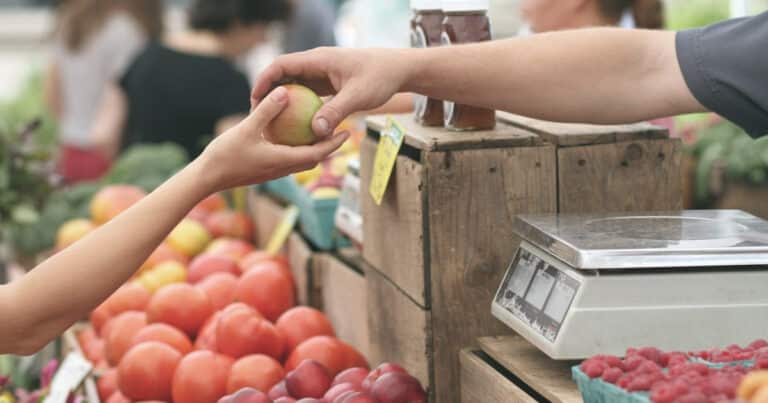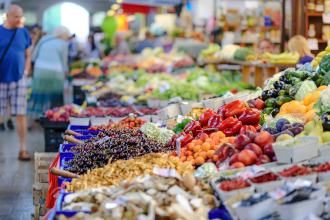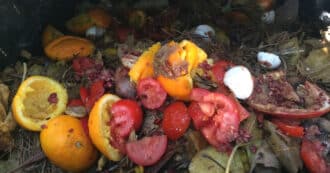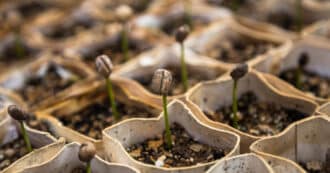By Sydney Cohen – What is sustainable food? Sustainable food is a term that has been used to describe the production of food in ways that are environmentally healthy, socially just, and economically viable.
An Un-Sustainable Food System
There are many harmful consequences that come from unsustainable farms and farming practices. These include land and water degradation, from mass-farming methods and agricultural pollutant runoffs that enter our land and waterways. Another consequence is the greenhouse gas emissions that result from burning fossil fuels, contributing to global warming.
A Sustainable Food System
A sustainable food system is an important component of addressing the causes of climate change. Up to 37% of global greenhouse gas emissions could be attributed to the food system. This includes crop and livestock production, transportation, changing land use (including deforestation), and food loss and waste.
Sustainable food systems start with the development of sustainable agricultural practices, development of more sustainable food distribution systems, creation of sustainable diets, and reduction of food waste throughout the system, say proponents of sustainable eating and saving money for health and the environment.
How Sustainable Food Impacts the Environment
Food is responsible for 60% of biodiversity loss worldwide according to the World Wildlife Fund (WWF). Sustainable food systems and agriculture attempt to conserve energy by using renewable energy sources such as wind and solar power. This creates a more sustainable food production, with less environmental harm.
Greenhouse Gas Emissions
As previously mentioned, the large, mass-producing agricultural farms around the world primarily run off of burning fossil fuels like coal, which is a large factor in global warming. The pollution from greenhouse gas emissions affects ecosystems around the world, in addition to human and wildlife health.
Sustainable Food Production
Sustainable agriculture is a production system that’s good for the environment. According to the One Earth Science & Technology Initiative, proper farming without the use of pesticides actually increases the soil’s carbon content and fertility in organic farming. In fact, according to the initiative, more than half of farmland in North America is now self-sufficient in terms of organic farming, and the majority are sustainable.
Choosing Sustainable Food
Sustainable eating is about choosing foods that are healthful to our environment and our bodies. According to the 2019 EAT-Lancet commission, a shift toward more plant-based foods would help feed the world’s growing population. Sustainable agriculture enables us to produce healthful food without compromising future generations’ ability to do the same.
Sustainable eating includes more legumes (beans, peas, lentils, peanuts, peanuts), whole grains, vegetables, fruits, and nuts, and less animal-based food, especially red meat and processed meat. Limiting refined grains and added sugars are encouraged as well. “Sustainable” is applied toward the production of plant and animal products using farming techniques and practices that help to conserve natural resources with minimal impact on the environment.
How You Can Contribute to Sustainable Food production
Choosing to eat organic produce is a more sustainable food option. When shopping, people should ask vendors if they grew the produce themselves, when it was picked and where their farm is located. You can contribute to sustainable agriculture by buying organic produce or from producers who engage in practices such as organic farming or regenerative farming.
The Difference Between Local Food and Sustainable Food
Farmer’s markets have created new opportunities for many farmers and customers across the world. Shopping at farmer’s markets is a more environmentally friendly option, as buying from local vendors and farmers means that there is less pollution involved in the transport of food and produce, creating a more sustainable practice.
While buying organic food is a method of eating sustainably, it is not quite the same as sustainable agriculture farms. The difference is that organic farming avoids using synthetic pesticides, GMOs, and fertilizers, while sustainable farming refers to the agricultural processes themselves, which aim to reduce erosion, keep more carbon in the soil, and preserve higher levels of organic matter.
Sustainable Food is Better for the Environment
Modern industrial agriculture is a system that erodes soils, pollutes air and water. Sustainable farms encourage biodiversity and conserve scarce water resources. They use less fossil fuel, produce fewer greenhouse gases, and often depend on human labor. Sustainable ranchers in California, for example, raise a moderate number of animals at a time and rotate the animals around a pasture to minimize their impact.
Sustainable businesses can green their businesses by using locally grown, sustainable ingredients, energy-saving production practices, and waste-free packaging. Restaurants and manufacturers also have a role to play and can use locally grown ingredients, like locally sourced ingredients and locally produced produce. The goal is to reduce environmental waste and pollutants that enter our air, water, and soil.
Choosing local produce cuts down on wasteful transportation emissions. Buying local produce also helps farm families stay on the land. Well-managed farms help preserve soil, protect water sources and remove carbon from the atmosphere. Buying local produce has been beneficial to our various ecosystems since the 1970s, as well as saving our environment and reducing greenhouse gas.
In particular, buying in-season produce is another smart and sustainable choice, because it is fresher causes less waste, and involves less transport.
Tips for Eating Sustainable Food
The best way to support sustainable farming is to buy locally. Eat seasonally, shop locally, and shop in bulk and opt for plant-based food choices, in order to minimize waste and reduce pollution. Ask your food providers to support local farmers and producers.
Choose less packaging and less waste and water to produce food. Aim to support businesses and brands that use less packaging, waste, energy, and water when creating your grocery list to get the most of your shopping for organic produce and healthier foods.
It’s important to support sustainable farming processes in order to reduce pollution. Not only are sustainable farms better for the environment, using fewer pesticides and fertilizers that contribute to water pollution, and avoiding burning fossil fuels whose emissions are causing global warming, but the food they produce is better for our bodies too!
This is why it is important to buy from local and sustainable farmers by making smart decisions about where your food comes from.
* Featured image source
Interested in learning more? Check out our post on The Principles of Sustainable Development.









